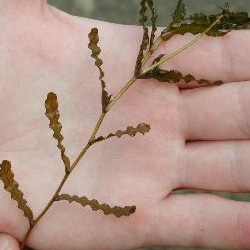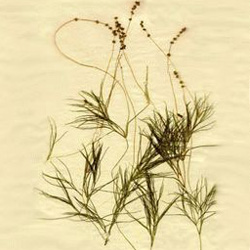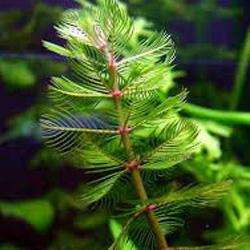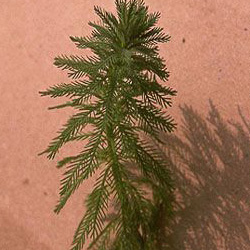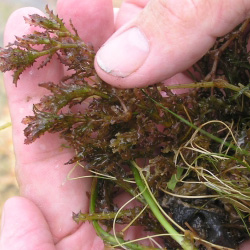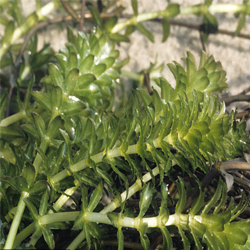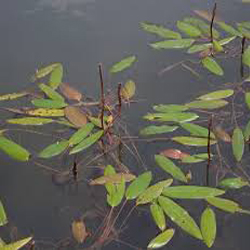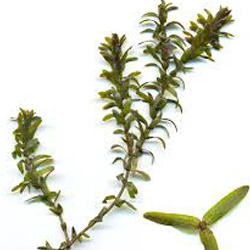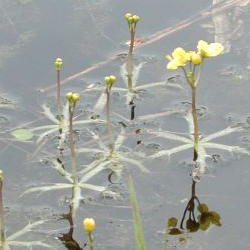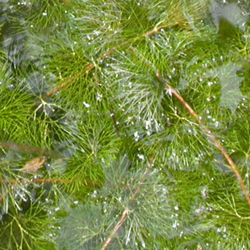Submersed Plants
Curly-Leaf Pondweed
Curly-leaf pondweed has a very distinct appearance with crinkled, oblong, blue-green leaves that attach to its spaghetti like stems in an alternate pattern. Curly-leaf pondweed produces small flowers that are arranged on dense terminal spikes that rise a few inches above the water. This pondweed is generally the first to appear in spring and dies in the mid-summer. This plants dead tissue can accumulate on shorelines and decay, resulting in lower dissolved oxygen levels within the water body. The die-off will also cause nutrients to be released from the plants, which can trigger algal blooms. Curly-leaf pondweed is considered a deep-water plant, but it will colonize in shallow water as well. With a strong rhizome anchoring system, it can grow in a variety of different locations and sediments. This plant can tolerate extreme conditions including low light and cold-water temperatures and has even been found growing under 20 inches of snow-covered ice. Curly-leaf pondweed actively grows during the winter months when most plants are dormant, providing a source of food and shelter for fish. Although it has some benefits, this invasive plant tends to drown out native submerged plant species and can grow to nuisance levels. It also reduces recreational opportunities by forming thick surface mats that can tangle swimmers and jam propellers.
Sago Pondweed
Sago pondweed is an aquatic plant that grows up to 3 feet tall. This plant is generally submersed except for its reproductive stalk, which grows above the water line and flowers from June to September. It does not have many branches at the base, but becomes more full towards the top. The stems are slender and flexible. The leaves are narrow, from 1 to 4 inches long and up to half inch wide. The flowers are very small and greenish and grow in several whorls along the flower spike. Sago pondweed is found in fresh to moderately brackish water and is generally not very competitive when there are other plants in the pond. Sago pondweed prefers slow moving or standing waters, but will tolerate strong waves and currents better than most plants because of its long roots and rhizomes. Sago pondweed is one of the most important sources of food for waterfowl in North America. The birds feed on the entire plant, particularly its nutrient-rich seeds and tubers. Pond owners are encouraged to control rather than eradicate Sago pondweed from their ponds.
Eurasian Watermilfoil
Eurasian watermilfoil is a non-native, submersed perennial. It has long underwater stems that branch out profusely when they reach the surface of the water. Leaves are whorled on the stem at each node. They are finely divided and feather-like in appearance. Stems reaching the surface often branch to form a thick canopy and produce small reddish flowers. Eurasian watermilfoil can grow in a variety of habitats and conditions, including shallow or deep water, fresh or brackish water and can tolerate a wide temperature range. It thrives in waters with an overabundance of nutrients, extensive motorboat use, and where it can get plenty of sunlight. The presence of Eurasian watermilfoil makes it difficult for some beneficial native species to compete and establish healthy growth, due to its tendency to branch out and form dense canopies over the water surface. This loss of native plant growth reduces food sources for fish and waterfowl, negatively effecting wildlife population. Dense beds of Eurasian watermilfoil make recreational activities nearly impossible.
Parrot Feather
Parrot feather is an invasive aquatic plant that it is now present in nearly every southern state. Its emergent leaves are whorled, stiff and usually have 20 or more linear divisions (10 leaflet pairs) on each leaf, they are feather-like and grayish green and can extend up to 12 inches long above the water surface. The submersed shoots (similar to those of Eurasian milfoil) are comprised of whorls of 4 or 5 filamentous leaves up to 1 inch long. Submersed leaves are redish-orange. When submersed shoots reach the water surface, plant growth changes and begins to creep along the water surface with extensive branching and nodes followed by vertical growth of emergent stems. Flowers grow from the emergent shoots and are small and white. Parrot feather grows in shallow wetlands, slow moving streams, irrigation reservoirs or canals, edges of lakes, ponds, sloughs, or backwaters. Although it can grow in moist soil and tolerates a wide range of water levels, parrot feather requires rooting in bottom sediments. So, habitats where light can penetrate to the bottom favor colonization. Parrot feather does not have tubers, turions or winter buds. Therefore, it uses its stolons (stems that grow at the soil surface or just below ground) for dispersal. Parrot feather prefers temperatures between 15 and 60 degrees Fahrenheit. Parrot feather grows vigorously and quickly once is present in a new habitat, forming dense canopies that occupy large amounts of space and block sunlight and oxygen exchange. As a result, it outcompetes and replaces native flora that might be more valuable to fish and wildlife. Parrot feather infestations choke waterways, inhibit recreational activities, blocks drainage and boost mosquito larva growth.
Naiad
Naiad, or Southern naiad, is found throughout the United States and prefers still or slow-moving water with depths of 3 to 15 feet. Naiad can tolerate polluted or slightly brackish water and a variety of sediments. The stems of naiad are very long and have many branches. Its leaves are deep green, less than 1/16 inch wide, with fine serrated margins. Naiad leaves are arranged oppositely on the stem and sometimes in whorls of three. The flowers are submerged, very small and unobtrusive. Naiad seeds and foliage are an important food source for wildlife, especially shorebirds and waterfowl. Modest growth of naiad is generally desirable for the pond ecosystem, however, these plants can become troublesome in ditches and human-made ponds by dominating other native vegetation and reducing dissolved oxygen levels leading to fish kills when these plants die in the fall. In larger water bodies, dense submersed mats can interfere with recreational activities. Excessive growth of naiad and southern naiad is a symptom of high nutrient levels within the water body.
Hydrilla
Hydrilla is an invasive aquatic perennial that grows rapidly, in some cases, up to an inch per day. Hydrilla stems are long and branching, forming intertwined mats at the water surface. Small spines give leaf margins a serrated appearance. The midrib is often spiny towards the base of the leaf, making it rough to the touch, and red in color when new. Leaves grow along the stem in whorls of 3-6 leaflets. Hydrilla plants are usually rooted to the lake bottom, coming to the surface from up to 12 feet deep. During the late growing season, small white tubers form on the plants’ roots that are used for food storage and allow the plant to survive over winter. Hydrilla resembles elodea and egeria, but neither elodea or egeria produce tubers and are smaller plants. Hydrilla can be found infesting freshwater ponds and lakes, rivers, impoundments, and canals. It tolerates a wide range of light and nutrient levels giving it the advantage over native species. Hydrilla can invade deep, dark waters where most native plants cannot grow. It blocks the sunlight and displaces native plants below with its thick, dense surface mats. Hydrilla decreases dissolved oxygen levels leading to fish kills. Hydrilla obstructs boating, swimming, and other recreational water activities.
Longleaf Pondweed
Longleaf pondweed, also known as American pondweed, is a native perennial aquatic plant common to the Southern Great Plains. It is rooted and typically does not grow in water more than 5 feet deep, and also prefers mucky bottoms. The leaves of the longleaf pondweed are attached to a stem that can grow up to 6 feet long. Floating, oval shaped leaves are 4-7 inches long and 1-2 inches wide, while the less abundant submerged leaves are smaller and blade-like. Flowers emerge from the water in densely packed spikes in July and August. Seed heads are brownish-red and extend above the water on slender stalks. Longleaf pondweed is a desirable plant, providing a good habitat for small fish and invertebrates, which are eaten by fish and waterfowl. However, like many aquatic plants, it can become overabundant and interfere with recreational activities.
Elodea
Elodea is a native, submerged aquatic plant that grows in freshwater ponds, lakes, and streams. A tenacious grower, it is considered a weed due to its ability to sprout and multiply in many habitats and conditions. Elodea is often confused with hydrilla and egeria. Elodea has long slender branched stems that can grow up to 20 feet, with whirls of three leaves around the stem. The leaves are dark-green and very small and thin. Elodea flowers from June to August, its flowers are white and violet, produced at the tip of the stalk and rise to or above the water surface. It reproduces primarily through stem fragments. Elodea provides cover for aquatic insects and fish and serves as a source of food for pond wildlife. It is one of few plants that provides underwater habitat during the winter months. Despite its benefits, Elodea is known to develop dense long stands that can prevent light from reaching other submerged plants and limit water movements affecting the balance of the ecosystem and interfering with recreational activities.
Bladderwort
Common bladderwort is a native of the Northern Hemisphere and grows in all fifty states. This free-floating plant has no roots and can be found floating at or below the water surface, or trailing along the bottom of lakes, ponds, slow moving streams and wetlands up to 6 feet deep. Leaves are alternate and ¾ to 2 inches long, with 1 or 2 main divisions from the base, each with alternate branches. Small reddish bladders extend from leaf filament axils. Leaves are mostly submerged, though it can grow above the waterline in wet muck. Stems are up to 8-inches long, few-branched, and often zigzag between the alternate leaves. Flowering stems have few widely spaced, scale-like leaves. Up to 20 bright yellow, ½ to ¾-inch snapdragon-like flowers grow at the top of a stout reddish-green stem, emerging up to 8-inches above the waterline. Bladderworts are carnivorous plants. The bladders are used to capture small aquatic organisms that provide the plant with nutrients. Bladderwort plants offer shade and habitat to fish and insects, as well as being food source to wildlife. Common bladderwort can often grow into extensive, dense colonies that hinder swimming, boating and other recreational activities.
Fanwort
Fanwort, also known as colomba, is a submerged, perennial and hardy aquatic plant native to the Southern United States. However, Fanwort is now found in most North-East States. Fanwort can tolerate a wide rage of temperatures and pH but prefers slow moving waters, including lakes and ponds. Fanworts delicate, green underwater leaves are fan-like and have an average width of 2 inches. The leaves are arranged in opposite pairs on the stem. Small oval floating leaves, ¼” long grow on the surface. Small, white or cream colored, ½” wide flowers develop among the floating leaves. Fanwort is a highly competitive plant that is capable of rapid growth that creates large, dense mats of vegetation. Sediment levels rise when the dense mats decay and dissolved oxygen levels in the water may be depleted, causing a fish kill. Fanwort can displace native species, reduce biodiversity, and impede fishing, swimming and boating.

